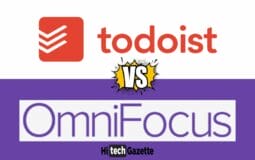Is your business or job suffering from your mismanaged lifestyle?
Task Management tools can help!
And if you’ve already been using outdated task management apps like Omnifocus, it’s time to switch to another time management app Todoist.
So, up next in this article, I’ll share some valid reasons why you should make the switch right away.
Let’s get started –
Accessibility
Omnifocus is a desktop app that syncs well with its iOS and Android apps. Todoist has a web app, mobile apps for both iOS and Android, and browser extensions.
However, Omnifocus lacks browser extensions. So, it’s nearly impossible to sync its native iOS/Android apps with the official website.
Easier to Use
Todoist is more intuitive than Omnifocus. And when I say intuitive, I mean it in the literal sense of the word. Todoist’s interface is cleaner and more straightforward than that of Omnifocus—it’s like having a personal assistant whispering in your ear what needs to get done next.
One of the biggest benefits of using Todoist over Omnifocus is its flexibility.
With Todoist, you can manage all your tasks from within one simple-to-use app on any device, no matter where you are or what you’re doing – at home on your desktop computer, at work on your laptop, or traveling via smartphone on the go!
You can even access it from any browser, so there’s never an excuse not to stay organized wherever life takes you!
More Themes, Colors, and Customization
Todoist has many more themes, colors, and customization options than Omnifocus. Themes in Todoist allow you to change the appearance of your task list by changing its background color, text color, and font size. You can also set different themes for different projects or contexts.
While you cannot change the background color of tasks in Omnifocus, you only get to switch it between light ad dark.
Additionally, these themes do not allow you to customize further than Todoist does.
Customizing the scheduling app as per your requirement gives you the personalized feel you need to manage your daily tasks.
And OmniFocus takes this away from you as there’s no easy way to create modernized themes as per your taste.
Therefore, causing an issue for some people who want total control over their task lists.
Smart Dates
Todoist’s smart dates feature is more flexible than the calendar system present in the OmniFocus app.
In Todoist, you can only create tasks with specific dates – for example, “Monday 3/4” or “Wednesday 5/6”. You can also set up recurring tasks that repeat every day, week, or month (for example, “Pay the rent on the first of every month”).
On the other hand, OmniFocus lacks these basic features by default.
Attachments and Notes in Todoist vs. Omnifocus
Attachments are another area where Todoist shines. While Omnifocus does support attachments, they can only be attached to projects and not individual tasks.
In Todoist, you can attach any type of file to individual tasks—images, documents, videos, and more. You can even add attachments from your computer or directly from the web using their built-in browser extension (more on that later).
And once they’re added, they’ll stay with the task until you decide to delete it or move it somewhere else.
And speaking of moving things around: while in Omnifocus, there’s no way to move a task between projects without creating a duplicate first, it’s easy in Todoist: just drag the task onto another project, and you’re done!
Todoist Integrations are Better than Omnifocus
Todoist has a lot of integrations with other services, apps, and devices. You can integrate Todoist with over 100+ apps, including Google Calendar, Gmail, Wunderlist, and others.
You can also integrate Todoist with other platforms like Slack or Zapier to get notifications whenever you add a task in Todoist.
Or suppose you want to automatically create actionable tasks from emails sent by your customers. In that case, you can use their email integration feature, which works for Gmail and Outlook users.
Better Management for Big Tasks
Todoist is better for big tasks that you need to break down into smaller tasks. It makes it easy to see your task as a whole and then breaks it down into manageable steps.
That’s great if you are trying to accomplish something like “re-organize my closet.”
Omnifocus, on the other hand, also has this feature, but only if your project is small enough that you can fit all of its details in one task list view.
Todoist vs Omnifocus? Todoist Wins!
The reasons I’ve mentioned here make a solid case for why switching from Omnifocus to Todoist would be best for most people.
The truth is, there are probably many more reasons than I could even begin to list in this article.
That being said, it’s important to note that some people prefer Omnifocus over Todoist—and I don’t mean just because they’re stuck in their ways or like the idea of being an early adaptor of something “new.”
But to be honest, I believe those who prefer Omnifocus have made a wrong choice as they’re simply missing out on some cool features Todoist offers.
It all comes down to personal preference at the end of the day and finding what works best for each person.
So it’s up to you whether you plan on sticking with Omnifocus task manager or switching to Todoist.
However, despite my detailed comparison, if you’re still confused, I’ll recommend you try Todoist for a week and then decide based on your personal experience.
I bet you’ll choose Todoist over Omnifocus.
Conclusion
So, this is it.
Have you made up your mind about the Todoist task manager?
Whatever your final decision is, do share it with us in the comments below.



